True thrush
True thrushes are medium-sized mostly insectivorous or omnivorous birds in the genus Turdus of the wider thrush family, Turdidae. The genus name Turdus is Latin for "thrush". The term "thrush" is used for many other birds of the family Turdidae as well as for a number of species belonging to several other families.
| True thrushes | |
|---|---|
 | |
| Male common blackbird (T. merula) | |
| Scientific classification | |
| Kingdom: | Animalia |
| Phylum: | Chordata |
| Class: | Aves |
| Order: | Passeriformes |
| Family: | Turdidae |
| Genus: | Turdus Linnaeus, 1758 |
| Species | |
|
See text | |
The genus has a cosmopolitan distribution, with species in the Americas, Europe, Asia, Africa and Australia. Several species have also colonised some oceanic islands, and two species have been introduced to New Zealand. Some New World species are called robins, the most well known of which is the American robin. Several species are migratory.
While some species are often split out of Turdus, the two small thrushes formerly separated in Platycichla by many authors have been restored to the present genus in recent years.
Taxonomy and systematics
The genus Turdus was introduced by the Swedish naturalist Carl Linnaeus in 1758 in the tenth edition of his Systema Naturae.[1] The type species was subsequently designated as the mistle thrush.[2] The name Turdus is Latin word for a "thrush".[3]
Extant species
Eighty-four extant species are recognized:[4]
| Image | Common Name | Scientific name | Distribution |
|---|---|---|---|
 | Yellow-legged thrush | Turdus flavipes | northern Colombia, Venezuela, far northern Brazil, Trinidad, and Tobago, as well as parts of the Pakaraima Mountains in western Guyana, eastern Brazil, eastern Paraguay, and far northeastern Argentina |
.jpg.webp) | Pale-eyed thrush | Turdus leucops | Bolivia, Brazil, Colombia, Ecuador, Guyana, Peru, and Venezuela |
 | African thrush | Turdus pelios | from Senegal and Gambia in the west to South Sudan, Ethiopia and Eritrea south to northwestern Zambia and western Angola |
 | Bare-eyed thrush | Turdus tephronotus | Ethiopia, Kenya, Somalia, and Tanzania |
.jpg.webp) | Kurrichane thrush | Turdus libonyana | Angola, Botswana, Burundi, Democratic Republic of the Congo, Lesotho, Malawi, Mozambique, Namibia, South Africa, Swaziland, Tanzania, Zambia, and Zimbabwe |
 | São Tomé thrush | Turdus olivaceofuscus | São Tomé |
| Príncipe thrush | Turdus xanthorhynchus | Príncipe | |
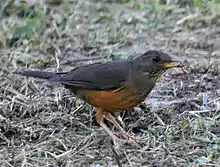 | Olive thrush | Turdus olivaceus | Tanzania and Zimbabwe in the north to the Cape of Good Hope |
 | Usambara thrush | Turdus roehli | Tanzania |
 | Abyssinian thrush | Turdus abyssinicus | Africa from South Sudan south to northern Mozambique. |
_on_lawn_(crop).jpg.webp) | Karoo thrush | Turdus smithi | South Africa, where it is present in Little Namaqualand, the Karoo and Northern Cape, Free State, Gauteng, Limpopo, Mpumalanga and parts of the North West Province. |
 | Somali thrush or Somali blackbird | Turdus ludoviciae | Somalia. |
| Taita thrush | Turdus helleri | Taita Hills in Kenya | |
| Yemen thrush | Turdus menachensis | Middle East | |
 | Comoro thrush | Turdus bewsheri | Comoros Islands |
 | Grey-backed thrush | Turdus hortulorum | northeastern China and Russia Far East and winters in southern China and northern Vietnam |
 | Tickell's thrush | Turdus unicolor | Himalayas, and peninsular India |
 | Black-breasted thrush | Turdus dissimilis | southwestern China |
 | Japanese thrush | Turdus cardis | central China and Japan and northern Laos and Vietnam |
 | White-collared blackbird | Turdus albocinctus | Bangladesh, Bhutan, India, Myanmar, Nepal and Pakistan |
_a_(4834220566).jpg.webp) | Ring ouzel | Turdus torquatus | western and central Europe and also in the Caucasus and in the Scandinavian mountains |
.jpg.webp) | Grey-winged blackbird | Turdus boulboul | south-eastern Asia from the Himalayas to northern Vietnam |
 | Common blackbird | Turdus merula | temperate Eurasia, North Africa, the Canary Islands, and South Asia |
 | Chinese blackbird | Turdus mandarinus | south, central and east China |
_1_cropped.jpg.webp) | Tibetan blackbird | Turdus maximus | Himalayas from northern Pakistan to southeastern Tibet |
 | Indian blackbird | Turdus simillimus | India and Sri Lanka |
 | Island thrush | Turdus poliocephalus | Taiwan, through South East Asia and Melanesia, to Samoa |
 | Chestnut thrush | Turdus rubrocanus | western Himalayas and central/southwestern China; it winters in Eastern Himalaya and northern Southeast Asia |
 | Kessler's thrush | Turdus kessleri | central China |
 | Grey-sided thrush | Turdus feae | north-east China and migrating to subtropical or tropical moist montane forest in India, and Indochina |
 | Eyebrowed thrush | Turdus obscurus | Siberia south to China and Southeast Asia. |
.jpg.webp) | Pale thrush | Turdus pallidus | south-east Siberia, north-east China and Korea and may breed in Japan |
 | Brown-headed thrush | Turdus chrysolaus | Sakhalin, the Kuril Islands, Japan, Ryukyu Islands, Taiwan, Hainan and the northern Philippines |
 | Izu thrush | Turdus celaenops | Izu and Ryukyu Islands of Japan |
 | Black-throated thrush | Turdus atrogularis | east of Europe to Western Siberia and north-west Mongolia. |
 | Red-throated thrush | Turdus ruficollis | Asia |
 | Naumann's thrush | Turdus naumanni | South Asia to Southeast Asia |
 | Dusky thrush | Turdus eunomus | south to southeast Asia, principally in China and neighbouring countries |
-6.jpg.webp) | Fieldfare | Turdus pilaris | northern Norway, northern Sweden, Finland, Belgium, Germany, Switzerland, Austria, the Czech Republic, Slovakia, Hungary, Poland and Siberia as far east as Transbaikal, the Aldan River, the Tian Shan Mountains in North West China, Anatolia, Israel, Iran and Northwest India, and occasionally Northeast India. It is a vagrant to Iceland, Greenland, Spitsbergen, the Canary Islands, the Balearic Islands, Madeira, Corsica, Sardinia, Sicily, Malta and Cyprus. It is a very rare breeder in the British Isles, but winters in large numbers in the United Kingdom, Southern Europe, North Africa and the Middle East. |
 | Redwing | Turdus iliacus | Europe and Asia, from Iceland south to northernmost Scotland, and east through Scandinavia, the Baltic States, northern Poland and Belarus, and through most of Russia to about 165°E in Chukotka Autonomous Okrug |
 | Song thrush | Turdus philomelos | southern Europe, North Africa and the Middle East |
 | Chinese thrush | Turdus mupinensis | China and far northern Vietnam |
 | Mistle thrush | Turdus viscivorus | Europe and temperate Asia |
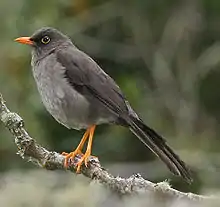 | Great thrush | Turdus fuscater | Andes in western and northern Venezuela as far as Lara and Trujillo, the Andes of Colombia, Ecuador, Peru, and finally, northwest Bolivia |
 | Chiguanco thrush | Turdus chiguanco | Ecuador and the Altiplano |
 | Sooty thrush | Turdus nigrescens | Costa Rica and western Panama |
 | Black thrush | Turdus infuscatus | El Salvador, Guatemala, Honduras, and Mexico |
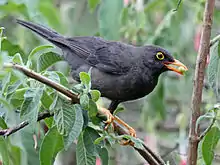 | Glossy-black thrush | Turdus serranus | northern Venezuela to northwestern Argentina. |
 | Andean slaty thrush | Turdus nigriceps | north-west Argentina, Bolivia, Ecuador and Peru |
 | Blacksmith thrush | Turdus subalaris | north-east Argentina, eastern Paraguay and southern Brazil |
 | Plumbeous-backed thrush | Turdus reevei | Ecuador and Peru |
_Waraira_Repano_National_Park.jpg.webp) | Black-hooded thrush | Turdus olivater | Venezuela and Colombia |
 | Marañón thrush | Turdus maranonicus | southern Ecuador and northern Peru |
.jpg.webp) | Chestnut-bellied thrush | Turdus fulviventris | western Venezuela, western Colombia, Ecuador, northern Peru and northwestern Bolivia. |
.jpg.webp) | Rufous-bellied thrush | Turdus rufiventris | southeast Brazil from Maranhão south to Rio Grande do Sul states, Bolivia, Paraguay, Uruguay and northern regions of Argentina |
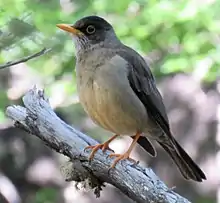 | Austral thrush | Turdus falcklandii | south Argentina and south and central Chile |
.jpg.webp) | Pale-breasted thrush | Turdus leucomelas | eastern and northern South America |
2.jpg.webp) | Creamy-bellied thrush | Turdus amaurochalinus | central and eastern South America |
.jpg.webp) | Mountain thrush | Turdus plebejus | southern Mexico to western Panama. |
.jpg.webp) | Black-billed thrush | Turdus ignobilis | western Amazonia and on the Guianan Shield, occurring in Bolivia, Brazil, Colombia, Ecuador, Peru, Venezuela, and Bolivia |
 | Campina thrush | Turdus arthuri | lowlands of se Venezuela, Guyana and Suriname, e Colombia and wc Amazonian Brazil |
| Pantepui thrush | Turdus murinus | foothills of s Venezuela and Guyana | |
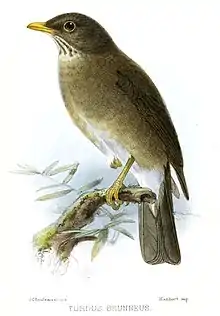 | Lawrence's thrush | Turdus lawrencii | Bolivia, Brazil, Colombia, Ecuador, Peru, and Venezuela |
 | Cocoa thrush | Turdus fumigatus | South America |
 | Pale-vented thrush | Turdus obsoletus | Colombia, Costa Rica, Ecuador, Panama, and Peru. |
 | Hauxwell's thrush | Turdus hauxwelli | Bolivia, Brazil, Colombia, Ecuador, Peru, and Venezuela. |
| Unicolored thrush | Turdus haplochrous | Bolivia. | |
.jpg.webp) | Clay-colored thrush | Turdus grayi | South Texas (where it is rapidly expanding its range) to northern Colombia; west and north of the Isthmus of Tehuantepec |
.jpg.webp) | Spectacled thrush | Turdus nudigenis | South America from Colombia and Venezuela south and east to northern Brazil. In Trinidad and Tobago |
 | Várzea thrush | Turdus sanchezorum | western Amazon |
_(20081987352).jpg.webp) | Ecuadorian thrush | Turdus maculirostris | western Ecuador and far northwestern Peru |
 | White-eyed thrush | Turdus jamaicensis | Jamaica |
.jpg.webp) | White-throated thrush | Turdus assimilis | Central America |
| Dagua thrush | Turdus daguae | Panama to north-western Ecuador | |
 | White-necked thrush | Turdus albicollis | eastern Brazil, far northern Uruguay, eastern Paraguay and far north-eastern Argentina |
 | Rufous-backed thrush | Turdus rufopalliatus | southeastern Sonora to the southeastern corner of Oaxaca along the coast and in the Río Balsas drainage. The isolated populations in Mexico City and Oaxaca City |
 | Rufous-collared thrush | Turdus rufitorques | Middle America, south of the Isthmus of Tehuantepec, occurring in El Salvador, Guatemala, Honduras, and Chiapas state in Mexico. |
 | American robin | Turdus migratorius | North America, from Alaska and Canada southward to northern Florida and Mexico |
 | La Selle thrush | Turdus swalesi | Hispaniola (Dominican Republic and Haiti) |
 | White-chinned thrush | Turdus aurantius | Jamaica |
_RWD.jpg.webp) | Red-legged thrush | Turdus plumbeus | the Bahamas, Cayman Brac, Cuba, Dominica, Hispaniola (Dominican Republic and Haiti), Puerto Rico |
| Forest thrush | Turdus lherminieri | Dominica, Guadeloupe, Montserrat, and Saint Lucia. | |
 | Tristan thrush | Turdus eremita | British overseas territories of the isolated Tristan da Cunha archipelago |
Extinct species
- †Grand Cayman thrush (Turdus ravidus)
Former species
Formerly, some authorities also considered the following species (or subspecies) as species within the genus Turdus:
- Rufous whistler (as Turdus pectoralis or Turdus prasinus)[5]
- Grey shrikethrush (as Turdus harmonicus)[6]
- †South Island piopio (as Turdus crassirostus)[7]
- Ethiopian oriole (as Turdus monacha)[8]
- Restless flycatcher (as Turdus inquietus)[9]
- Black-headed bulbul (as Turdus atriceps)[10]
- Ruby-throated bulbul (as Turdus dispar)[11]
- Red-vented bulbul (as Turdus cafer)[12]
- Sooty-headed bulbul (as Turdus aurigaster)[13]
- African red-eyed bulbul (as Turdus aurigaster)[14]
- Cape bulbul (as Turdus capensis)[15]
- Common bulbul (as Turdus barbatus)[16]
- Egyptian bulbul (as Turdus Arsinoe)[17]
- Orange-spotted bulbul (as Turdus bimaculatus)[18]
- Yellow-vented bulbul (analis) (as Turdus analis)[19]
- Sombre greenbul (as Turdus importunus)[20]
- Réunion bulbul (as Turdus Borbonicus)[21]
- Mauritius bulbul (as Turdus atricilla)[22]
- Malagasy bulbul (as Turdus Madagascariensis)[23]
- Black bulbul (as Turdus leucocephalus)[24]
- Philippine bulbul (as Turdus philippinus)[25]
- Brown-eared bulbul (as Turdus amaurotis)[26]
References
- Linnaeus, Carl (1758). Systema Naturae per regna tria naturae, secundum classes, ordines, genera, species, cum characteribus, differentiis, synonymis, locis (in Latin). Volume 1 (10th ed.). Holmiae:Laurentii Salvii. p. 168.
- Mayr, Ernst; Paynter, Raymond A. Jr, eds. (1964). Check-list of Birds of the World. Volume 10. Cambridge, Massachusetts: Museum of Comparative Zoology. p. 177.
- Jobling, James A (2010). The Helm Dictionary of Scientific Bird Names. London: Christopher Helm. p. 293. ISBN 978-1-4081-2501-4.
- Gill, Frank; Donsker, David, eds. (2018). "Thrushes". World Bird List Version 8.1. International Ornithologists' Union. Retrieved 10 May 2018.
- Australia, Atlas of Living. "Pachycephala (Alisterornis) rufiventris rufiventris | Atlas of Living Australia". bie.ala.org.au. Retrieved 2017-02-06.
- "Colluricincla harmonica - Avibase". avibase.bsc-eoc.org. Retrieved 2017-02-17.
- The Ibis. British Ornithologists' Union. 1873-01-01.
- "Oriolus monacha - Avibase". avibase.bsc-eoc.org. Retrieved 2017-02-28.
- "Myiagra inquieta - Avibase". avibase.bsc-eoc.org. Retrieved 2017-01-26.
- "Brachypodius atriceps - Avibase". avibase.bsc-eoc.org. Retrieved 2017-03-10.
- "Pycnonotus dispar - Avibase". avibase.bsc-eoc.org. Retrieved 2017-03-11.
- "Pycnonotus cafer - Avibase". avibase.bsc-eoc.org. Retrieved 2017-03-25.
- "Pycnonotus aurigaster - Avibase". avibase.bsc-eoc.org. Retrieved 2017-03-25.
- "Pycnonotus nigricans - Avibase". avibase.bsc-eoc.org. Retrieved 2017-03-26.
- "Pycnonotus capensis - Avibase". avibase.bsc-eoc.org. Retrieved 2017-03-27.
- "Pycnonotus barbatus barbatus - Avibase". avibase.bsc-eoc.org. Retrieved 2017-03-27.
- "Pycnonotus barbatus arsinoe - Avibase". avibase.bsc-eoc.org. Retrieved 2017-03-27.
- "Pycnonotus bimaculatus - Avibase". avibase.bsc-eoc.org. Retrieved 2017-03-29.
- "Pycnonotus goiavier analis - Avibase". avibase.bsc-eoc.org. Retrieved 2017-03-30.
- "Andropadus importunus - Avibase". avibase.bsc-eoc.org. Retrieved 2017-04-10.
- "Hypsipetes borbonicus (Reunion Bulbul) - Avibase". avibase.bsc-eoc.org. Retrieved 2017-10-25.
- Newton, Alfred (1870). Extracts from the Record of Zoological Literature, Vols. I-VI: Containing the Portions Relating to Aves, from 1864 to 1869. Taylor & Francis.
- "Hypsipetes madagascariensis (Madagascar Bulbul) - Avibase". avibase.bsc-eoc.org. Retrieved 2017-10-29.
- "Hypsipetes leucocephalus (Himalayan Black Bulbul) - Avibase". avibase.bsc-eoc.org. Retrieved 2017-11-01.
- "Hypsipetes philippinus (Philippine Bulbul) - Avibase". avibase.bsc-eoc.org. Retrieved 2017-11-03.
- "Hypsipetes amaurotis (Brown-eared Bulbul) - Avibase". avibase.bsc-eoc.org. Retrieved 2017-11-06.
Further reading
- Voelker, G.; Rohwer, S.; Bowie, R.C.K.; Outlaw, D.C. (2007). "Molecular systematics of a speciose, cosmopolitan songbird genus: defining the limits of, and relationships among, the Turdus thrushes". Molecular Phylogenetics and Evolution. 42 (2): 422–434. doi:10.1016/j.ympev.2006.07.016. PMID 16971142.
External links
| Wikimedia Commons has media related to Turdus. |
- Videos, photos and sounds - The Internet Bird Collection